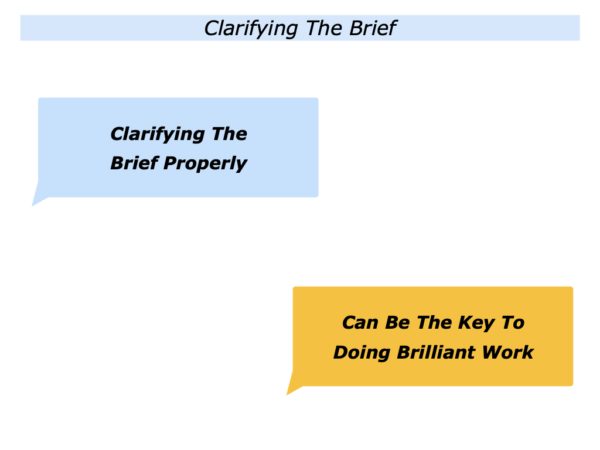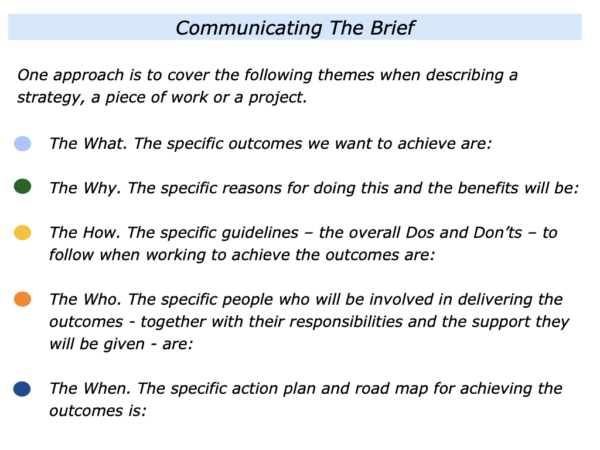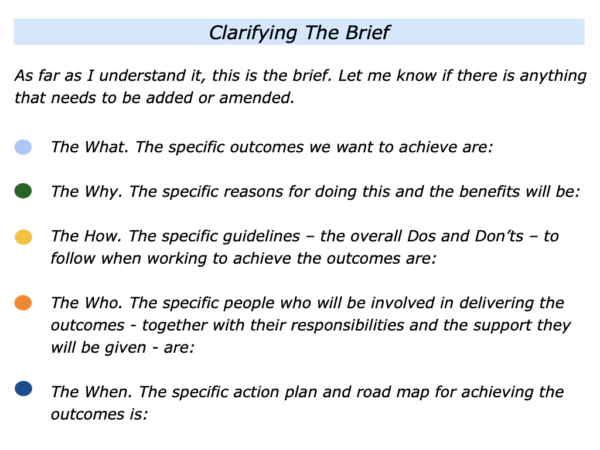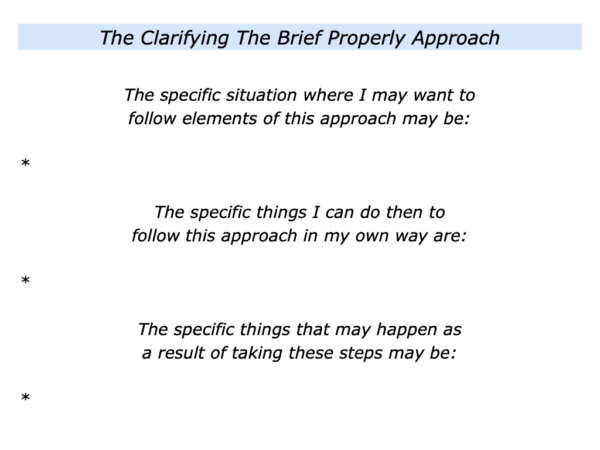
There are many ways to do fine work. One approach is to make sure there is a clear brief about the outcomes to achieve. This enables people to get the basics right and do brilliant work.
This is a vital step when working with external clients. It can be just as important when working with people within an organisation. Providing a clear brief can set people up to achieve success.
Clear contracting is vital in many areas of life. This is especially so when either:
You are giving a brief to a person, team or people in an organisation;
You are checking that you have understood a brief properly after it has been given to you by your boss, a customer or another person.
Some people get into trouble because the brief is not clear or they have not even been given a brief. This can happen in organisations that do not have clear goals or leave it up to people to interpret a brief in their own ways.
Great workers ensure that a brief is clear. This provides a framework that people can follow to do fine work. Let’s explore how to follow this approach when communicating and clarifying a brief.
Communicating The Brief
Imagine that you are a leader who aims to describe a strategy, a piece of work or a project. Clarity is vital. It is important to communicate a clear brief to give people context and describes the outcomes to achieve.
There are many models for giving such a brief. Some people draw on elements of military missions. Such missions often embody the following qualities. They aim to communicate:
A clear and achievable goal … A strategy that can work and the resources required to achieve the goal … A clear time frame and the equivalent of an exit strategy.
Some leaders also use the What, Why, How, Who and When approach. They give people the big picture and context. They then describe the outcomes to achieve, the guidelines to follow and people’s roles in achieving the aims.
Imagine you want to follow this approach when describing a strategy, a piece of work or a project. The following section provides a framework you can use to communicate the brief.
You will adapt this framework in your own way, of course, and use examples to bring it to life. It can then be important to give people the opportunity to ask questions for information so that they are crystal clear on the brief. Here is the framework.

Good leaders recognise that people often work best when they understand the big picture and their part in achieving the goals. They therefore take the following steps to make sure that everybody is on the same page.
They communicate the context, describe the outcomes to achieve – plus the reasons and benefits – and make sure that everybody is clear on the brief;
They make clear contracts about people’s contributions, give them the support to do the job and then manage by outcomes on the way towards delivering the brief;
They encourage people to perform superb work, inform them about the progress being made – plus any changes – and enable people to do their best to deliver the brief.
This is the ideal scenario. There may be times, however, when people are asked to do things but are unclear on the brief. Let’s explore how to manage this kind of situation.
Clarifying The Brief
Imagine that somebody has asked you to follow a strategy, perform a piece of work or do a project. Some organisations simply order people to do things without giving context or clarity about the outcomes to achieve.
You can simply to get on with the work and assume you know what is required. This can be challenging, however, and sometimes the confusion can lead to not being able to deliver the goods.
What to do in such a situation? One approach is to behave in a positive and professional way but also aim to clarify the brief. If appropriate, you can take the following steps. You can aim:
To clarify your understanding of the outcomes to achieve by doing your own background research about the strategy, piece of work or project;
To clarify your provisional understanding by then putting together what you believe to be the plan – the What, Why, How, Who and When;
To clarify the actual plan by, when appropriate, checking out your understanding with the person who has asked you to perform the work.
This final part may need to be done in a careful and professional way. One approach is to say something along the following lines when approaching the person who communicated the task.
“I wonder if it is possible for me to check something out with you to make sure I am working towards the right goals. As far as I understand it:
“The outcomes to achieve are … The guidelines to follow are … The time frame is …
“Is that right? Are there any other aims to add or things that I should bear in mind?”
This is the short version for checking out if you have understood the brief. Such an approach may help to clarify the outcomes to achieve – plus the guidelines to follow – and enable you to get on with the work.
Another approach is to play back and check out a fuller version of the What, Why, How, Who and When. This may or may not be appropriate, but it can help to fill in the whole picture.
Here is a framework you can use for taking this approach. You will do this in an appropriate way, of course, to have a positive conversation. This can help you to clarify and then do your best to deliver the brief.

There are many ways to do fine work. As mentioned earlier, one approach is make sure there is a clear brief. Taking this approach can help to set people up to achieve success.
Let’s return to your own life and work. Looking ahead, can you think of a situation where you may want to follow elements of this approach? How can you do this in your own way?
If you wish, try tackling the exercise on this theme. This invites you to complete the following sentences.



Leave a Reply